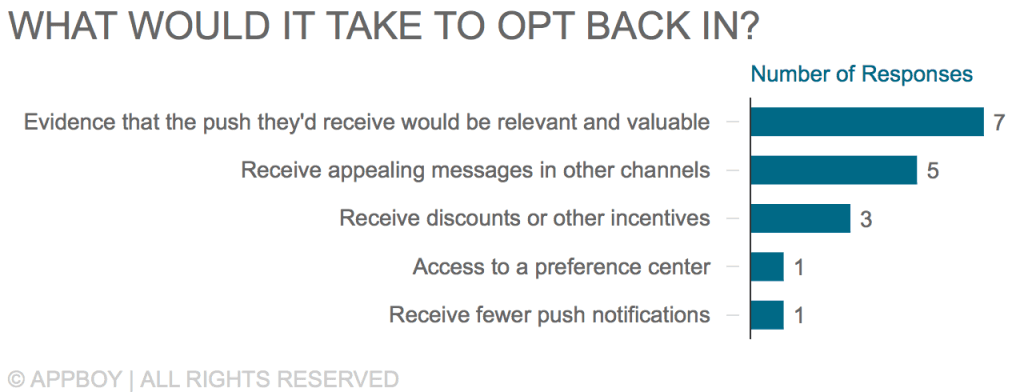Don’t Push Me: What Makes Users Opt Out of Push Notifications
Published on May 09, 2016/Last edited on May 09, 2016/12 min read


Todd Grennan
Content Production Principal, Content Marketing at BrazeDear reader: This blog post is vintage Appboy. We invite you to enjoy the wisdom of our former selves—and then for more information, check out our new Cross-Channel Engagement Difference Report.
Push notifications are a great way to make your brand’s voice heard. This powerful messaging channel allows brands to reach any customer, any time with effective, eye-catching messages across a wide variety of devices, making it easier to build an enduring customer/brand relationship.
In theory, at least.
It’s not that push isn’t a great way to engage customers, or that the promise of this channel has been oversold. But while the positive impact of push is very real, many brands find that their ability to use this channel to effectively reach their audience has been limited by customers’ reluctance to opt-in. There’s the rub: you can’t send push notifications to a customer who hasn’t agreed to receive them. And according to research carried out by Braze (you know, us), 60% of iOS users and 40% of Android users opt out push notifications.
To ensure that this channel is a useful one, brands can encourage their customers to opt in and stay opted in for push notifications. The first step? Understanding what makes them opt out in the first place.
We asked 14 Braze staff members to weigh in on how often they opt out of push notifications, what factors influence their decision, and what it would take for them to opt back in. While the results of this inquiry clearly aren’t statistically significant, they do provide a unique window into how people think about push. Take a look!
How often do people opt out of push notifications?

The 14 people we spoke to had a combined 1,526 apps installed on their phones, which works out to an average of 109 per phone. And while you might expect people working in tech to have a higher than average number of apps installed, that number is a little smaller than the 119 apps installed by the average iPhone user. However, there was a great deal of variance between individual respondents, with one person reporting only 23 apps on their phone, and another listing 297 apps on the two phones they carry.
In total, respondents opted out of push notifications from 584 of those apps, for a push opt-out rate of 38.3%. (That rate drops to 24.5% with Mr. 297 excluded.) Both those rates are lower than the average opt-out rate for Android devices and significantly lower than the rate for iOS devices; however, given that Braze employees work in a field where messaging is of significant interest, they may be less likely to opt out of push for professional reasons. It’s also worth noting that there was wide range of behavior here, too. Multiple respondents reported opting out of virtually all push notifications right off the bat, while one person said they opted in to nearly every app that asked to send push.
While our pool of respondents contains both people generally open to opting in for push, and others who are extremely reluctant to do so, our examination didn’t find any real absolutists on the subject. Not a single respondent reported opting out of push notifications from every app they downloaded. Similarly, every respondent said that they had opted out of receiving push from a least a few apps.
That’s significant, because it means that even people who rarely opt in for push notifications are open to doing so under the right circumstances. But, by the same token, even people who nearly always agree to enable push are willing to cut a brand off if they’re messaged in ways that don’t work for them. That makes understanding their motivations even more important.
What leads people to opt out of push notifications?
When we asked respondents about their reasons for opting out of receiving push notifications, four major factors emerged:

1. 30% opted out because they received push notifications that weren’t personalized or relevant to them
Our respondents’ biggest pet peeve? Receiving push notifications from brands that are irrelevant and don’t convey an understanding of them as customers. Unfortunately, getting these kinds of messages is far from rare—78% of consumers reported that most of the push notifications they receive are irrelevant, according to a survey conducted by Delvv.
Berin Bezmen, Appboy solutions consultant:
“I don’t want to be notified on something that is not relevant to me. For example, if a department store is having a sale on men’s shoes—that is not relevant to me at all.”
Matt Willett-Jeffries, Braze support engineer:
“I want to spend as little time as possible looking at my push notifications, while still obtaining as much relevant and useful information from them as I can. As a result, I chose to opt out of push in order to keep my push notifications both relevant and sparse.”
Paul Jonart, Braze success regional lead:
“I opt out of ones that are clearly marketing-driven and not specific to me or my engagement (i.e. driving app usage when I am not really engaged with the brand/product).”
2. 25% opted out because they received too many push notifications
Push fatigue is a real problem. While push notifications are a powerful and effective way to reach customers with urgent messages, the attention-getting nature of this outreach channel can make it feel intrusive or overwhelming if used too frequently.
Donte Ledbetter, Braze content producer:
“If the push notifications become too frequent … I won’t hesitate to opt out, or even uninstall the app, depending on my use of the app. There are only certain apps that I don’t mind seeing frequent push notifications from.”
Marion Nammack, Braze customer success manager:
“I don’t like it when apps I rarely use try to sell me things—so if I’m getting weekly notifications from an app I rarely use, I’ll either opt out or uninstall.”
Berin Bezmen, braze solutions consultant:
“I don’t like receiving notifications and pushes multiple times a day. I get annoyed.”
3. 25% opted out because that’s their default response to being asked to enable push
For some of our respondents, all push notifications are suspect until proven otherwise. In some cases, respondents find this message type distracting and seek to limit how many they receive. For others, they’ve had too many negative experiences with previous brands to opt in for push without a good reason. In either case, this is a particularly tough prejudice to overcome, because it requires customers to change their regular behavior.
Tola Lakavivat, Braze operations analyst:
“I default opt-out of [push for] any app I install, as I don’t want to have to grab for my phone unless an actual person is trying to reach me.”
Tina Lau, Braze database marketing manager:
“I don’t usually opt in for push on apps that I’m just testing out for the first time.”
Sal Poliandro III, Braze DevOps engineer:
“I generally out of push until I see the value of them within the app. Push notifications were abused for a long time by companies, which resulted in my default being opt-out.”
4. 20% opted out because they had no interest in receiving messages from the brand in question
Just because someone downloads an app, it doesn’t necessarily follow that they’re interested in receiving messages from the brand behind it. Maybe they only downloaded your app for a single, specific reason; maybe they dislike being interrupted by notifications and only opt in for push notifications for certain types of app. Whatever the reason, these are likely to be particularly difficult customers to convince to opt in.
Madhuri Shekar, Braze senior producer for audience development:
“If a push notification can directly and immediately impact my day for the better, then I turn them on. By and large, I turn off push notifications for any entertainment-related apps (especially social networking—Facebook and Twitter), but leave them on for things that affect my immediate productivity, such as calendar notifications, Uber/Lyft, etc. I also leave messaging notifications on.”
Robbie Matthews, Braze customer success manager:
“I don’t like push when it’s used as a sales medium. I’ve uninstalled a lot of commerce apps due to the sales element to them. That said, the transactional push are really helpful as reminders.”
Anushka Chhaya, Braze accounting manager:
“I don’t like to be bothered during the day—I barely even like getting text notifications or WhatsApp push notifications. I like to have the ability to log into apps and check on my own accord. That being said, it’s really helpful to have an app remind me of something that needs to be addressed. Which is why I have the task and calendar apps’ push enabled.”
What does it take for people to opt back in for push?
Every respondent expressed at least a tentative willingness to opt back in for push notifications under the right circumstances. However, there was a range of responses when it came to what those circumstances would need to be. The most common factors cited by respondents were:

1. 41.2% would need to see evidence that they’d receive push notifications that were valuable to them
Successful messaging is messaging that demonstrates its relevance and value to the people receiving it. So it’s not surprising that respondents who opted out were willing to consider changing their mind if brands successfully sold them on the benefits of receiving push.
Sal Poliandro III, Braze DevOps engineer:
“If the value of any notification was measured against the cost of context-switching and the interruptions [associated with each push], I would be way more likely to opt in. That’s just not the mindset of companies. They don’t seem to realize that making the notifications pretty or giving them catchy subject lines doesn’t make them stand out, because everyone is doing it. They need to add value to the interruption and be precise in the information they deliver.”
Anushka Chhaya, Braze accounting manager:
“If a brand engaged me with something relevant to that day specifically, or to my day-to-day, I would be really inclined to enable push notifications for that app specifically.”
2. 29.4% would need to receive appealing messages in other channels
For nearly a third of respondents, multichannel messaging—done right—is key to getting them to agree to opt back in for push notifications. While push notifications often get the lion’s share of the attention, other outreach types, such as in-app messages, email, and News Feed Cards, can be effective ways for brands to engage their customers, especially ones who have opted out of push.
Donte Ledbetter, Braze content producer:
“Not only would they have to make a compelling case to encourage me to change my mind, they would also have to demonstrate through other channels that their messaging is valuable. For example, if the in-app messages and emails I receive are highly personalized, and they can make a compelling case through another channel for turning on mobile push notifications, I’m more likely to change my mind and opt in to push again.”
Paul Jonart, Appboy success regional lead:
“If they send an email explaining why I should re-opt in and it was beneficial to me, I might change my mind.”
Tina Lau, Braze database marketing manager:
“If I’ve already opted out of push for a brand, I would opt back in if I started engaging with the brand elsewhere (email, social, etc.) and discovered some value.”
Robbie Matthews, Braze customer success manager:
“They could use other methods—in-app [messages], education tips—to draw me toward seeing the value [of opting in for push notifications] … and then I may be inclined to change my mind.”
3. 17.6% would need to be offered discounts or other incentives to re-enable push
Getting people to change their mind isn’t easy. But there’s a simple way to encourage people to opt back in for push notifications—give them concrete incentives to do so. That could be a discount, early access to content, loyalty points, or something else. The important thing is to make sure that the incentives your brand offers speak to the people you’re trying to reach; otherwise, you’re not likely to persuade many of them to enable push.
Madhuri Shekar, Braze senior producer for audience development:
“[I’d only opt back in for push] if I’m promised that push notifications would give me an immediate, time-sensitive offer that I need to act on immediately to benefit from.”
Jen McNamee, Braze channel development manager:
“I think that if brands offered incentives … I would [opt back into push]. For example, if they provided deals, money off.”
Berin Bezmen, Braze solutions consultant:
“I think people love promotions and discounts, so [if a brand states] that opting in will notify me on promotions, then I will most likely opt in.”
Other positive factors highlighted by our respondents were:
- Having a preference center to allow customers more control over the frequency and content of the push notifications they received
- Sending customers fewer push notifications
What now?

Push is only becoming more important. Web push notifications and wearables push are starting to take off, making it even more important for brands to think seriously about how to encourage their customers to opt in (and remain opted in) for push on a variety of different platforms and devices.
How do you do that? First, show your audience the value of opting in for push notifications by priming for push. When it makes sense for your brand, use push re-permission campaigns to convince persuadable customers to re-enable push notifications. And keep your audience’s experience of your messaging and your brand top of mind.
Related Tags
Be Absolutely Engaging.™
Sign up for regular updates from Braze.
Related Content
View the Blog
How behavioral marketing turns data into personalized experiences

Team Braze

Experience optimization: Turning data insights into better journeys

Team Braze

December 2025 Bonfire Marketer of the Month: Jagex’s Emma Oliver
